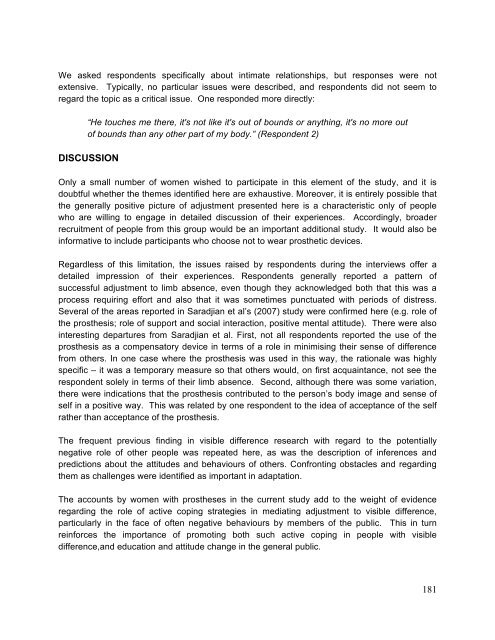Download the report - The Healing Foundation
Download the report - The Healing Foundation
Download the report - The Healing Foundation
Create successful ePaper yourself
Turn your PDF publications into a flip-book with our unique Google optimized e-Paper software.
We asked respondents specifically about intimate relationships, but responses were not<br />
extensive. Typically, no particular issues were described, and respondents did not seem to<br />
regard <strong>the</strong> topic as a critical issue. One responded more directly:<br />
“He touches me <strong>the</strong>re, it's not like it's out of bounds or anything, it's no more out<br />
of bounds than any o<strong>the</strong>r part of my body.” (Respondent 2)<br />
DISCUSSION<br />
Only a small number of women wished to participate in this element of <strong>the</strong> study, and it is<br />
doubtful whe<strong>the</strong>r <strong>the</strong> <strong>the</strong>mes identified here are exhaustive. Moreover, it is entirely possible that<br />
<strong>the</strong> generally positive picture of adjustment presented here is a characteristic only of people<br />
who are willing to engage in detailed discussion of <strong>the</strong>ir experiences. Accordingly, broader<br />
recruitment of people from this group would be an important additional study. It would also be<br />
informative to include participants who choose not to wear pros<strong>the</strong>tic devices.<br />
Regardless of this limitation, <strong>the</strong> issues raised by respondents during <strong>the</strong> interviews offer a<br />
detailed impression of <strong>the</strong>ir experiences. Respondents generally <strong>report</strong>ed a pattern of<br />
successful adjustment to limb absence, even though <strong>the</strong>y acknowledged both that this was a<br />
process requiring effort and also that it was sometimes punctuated with periods of distress.<br />
Several of <strong>the</strong> areas <strong>report</strong>ed in Saradjian et al’s (2007) study were confirmed here (e.g. role of<br />
<strong>the</strong> pros<strong>the</strong>sis; role of support and social interaction, positive mental attitude). <strong>The</strong>re were also<br />
interesting departures from Saradjian et al. First, not all respondents <strong>report</strong>ed <strong>the</strong> use of <strong>the</strong><br />
pros<strong>the</strong>sis as a compensatory device in terms of a role in minimising <strong>the</strong>ir sense of difference<br />
from o<strong>the</strong>rs. In one case where <strong>the</strong> pros<strong>the</strong>sis was used in this way, <strong>the</strong> rationale was highly<br />
specific – it was a temporary measure so that o<strong>the</strong>rs would, on first acquaintance, not see <strong>the</strong><br />
respondent solely in terms of <strong>the</strong>ir limb absence. Second, although <strong>the</strong>re was some variation,<br />
<strong>the</strong>re were indications that <strong>the</strong> pros<strong>the</strong>sis contributed to <strong>the</strong> person’s body image and sense of<br />
self in a positive way. This was related by one respondent to <strong>the</strong> idea of acceptance of <strong>the</strong> self<br />
ra<strong>the</strong>r than acceptance of <strong>the</strong> pros<strong>the</strong>sis.<br />
<strong>The</strong> frequent previous finding in visible difference research with regard to <strong>the</strong> potentially<br />
negative role of o<strong>the</strong>r people was repeated here, as was <strong>the</strong> description of inferences and<br />
predictions about <strong>the</strong> attitudes and behaviours of o<strong>the</strong>rs. Confronting obstacles and regarding<br />
<strong>the</strong>m as challenges were identified as important in adaptation.<br />
<strong>The</strong> accounts by women with pros<strong>the</strong>ses in <strong>the</strong> current study add to <strong>the</strong> weight of evidence<br />
regarding <strong>the</strong> role of active coping strategies in mediating adjustment to visible difference,<br />
particularly in <strong>the</strong> face of often negative behaviours by members of <strong>the</strong> public. This in turn<br />
reinforces <strong>the</strong> importance of promoting both such active coping in people with visible<br />
difference,and education and attitude change in <strong>the</strong> general public.<br />
181


